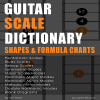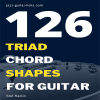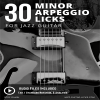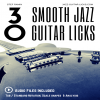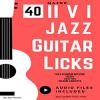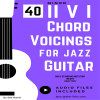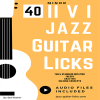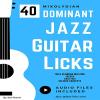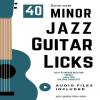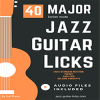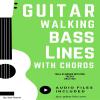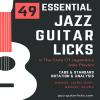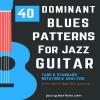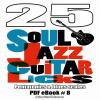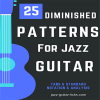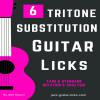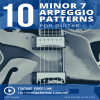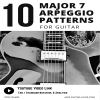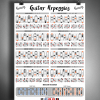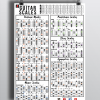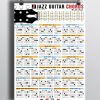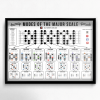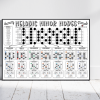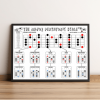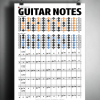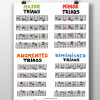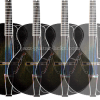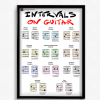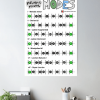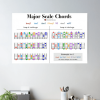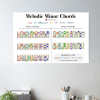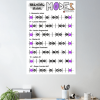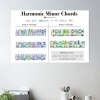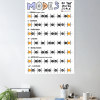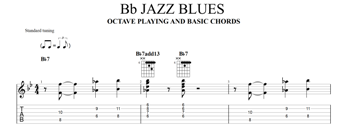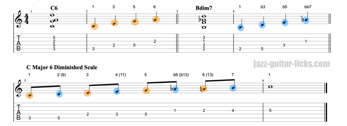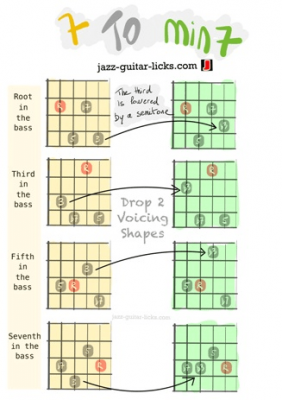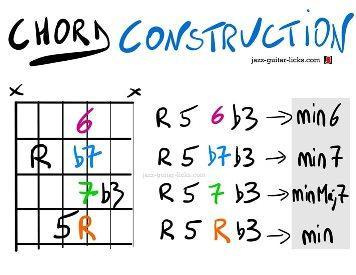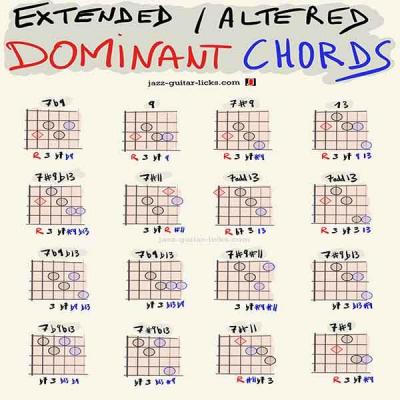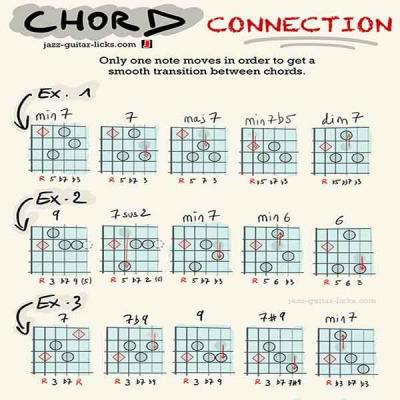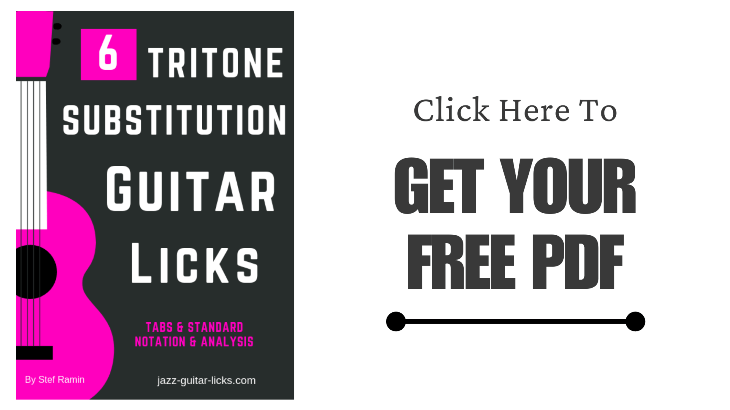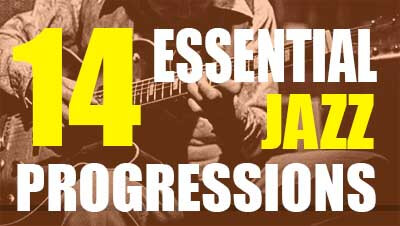
The 14 Most Important Jazz Chord Progressions
- By jazz-guitar-licks
- On 2017-10-30
- In Jazz Guitar Lessons
- 10 comments
In this lesson you will learn to recognize 14 important jazz chord progressions as minor and major II-V-I, turnarounds and their variations, how to use diminished passing chords...etc.
You will also find charts with roman numerals to easily transpose these harmonic progressions in different keys and some examples of comping with audio files, tabs and standard notation.
SUMMARY
2 - ii - V7alt - I
4 - Imaj7 - vim7 - iim7 - V7 (Basic turnaroud)
5 - Turnaround variation - Imaj7 - VI7 - iim7 - V7 (Rhythm changes)
6 - Turnaround variation - Imaj7 - I#dim7 - iim7 - V7 (Diminished passing chord)
7 - Turnaround variation - iiim7 - VI7b9 - iim7 - V7
8 - Turnaround variation - III7 - VI7 - II7 - V7
9 - Turnaround variation - Tritone substitution
10 - I7 - VI7 - iim7 - V7alt (Jazz, blues turnaround)
11 - I7 - IV7 (movement by fourths)
12 - Imaj7 - II7 - IIm7 - V7 - Imaj7 (Take the A train)
13 - Imaj7 - #Idim7 - IIm7 - #IIdim7 - IIIm7 - VI7 (Passing diminished 7 chords)
14 - IVmaj7 - ivm7
Jazz chord progression # 1 | ii - V7 - I (major)
What's the Major ii-V-I Sequence?
It is obvious that the first chord progression to master is the major II-V-I sequence (A.K.A 2 5 1). It is the most used chord progression found in jazz music. The II-V-I cadence contain three basic chords built from the first (I), second (II) and fifth (V) degree of the major scale.
Each degree corresponds to a chord, it means that we will play a minor seventh chord on the degree II, a dominant seventh chord on the degree V and a major seventh chord on the degree I. Which makes in the key of C major Dm7 (II), G7 (V) and Cmaj7 (I), three four-note chords built by stacking thirds.
| Dm7 | G7 | Cmaj7 |
| iim7 | V7 | Imaj7 |
One Chord Per Measure
You can find the ii V I progression with two chords per measure. The first example uses two basic drop 2 chords (Dm7 and Cmaj7 on the II and I degrees and a G7 drop 3 voicing on the V.
This second example has extended chords. Dm11 instead of Dm7 and G9 in place of G7.

2 Chords / Measure
It is common to see II-V-I with two chords per measures, generally the ii and the V are played in the same bar. In this example the minor and the dominant chords are extended with a ninth.

Jazz Standards That Use II-V-I Progressions
- SUMMERTIME (A-7, D7) Sometimes the II -V doesn't resolve to the I.
- AUTUMN LEAVES (A-7, D7, Gmaj7).
- TUNE UP (E-7, A7, Dmaj7).
- ALL THE THINGS YOU ARE (Bb-7, Eb7)
- IN A MELLOW TONE (C-7, F7, Bbmaj7)
And many, many, many more...
Jazz chord progression # 2 | ii - V7alt - I
How to Alter the V Chord of a ii-V-I Progression?
As seen previously, the II-V-I progression is quite easy to play and ear. It is a nice introduction to jazz comping. However, only playing notes of the diatonic scale can be boring in the long run.
The next step in exploring the most important jazz chord progression is to consider the V7 as an altered chord (Valt or V7alt). It means that we will add altered notes not present in the original scale (the major scale). These altered notes are b9, #9 #11 (b5) and b13 (#5).
This will create tension, an imbalance of the V7 chord which should resolve to the I chord to release this tension. The new progression is now ii-V7alt-I.
There is no change for the minor (II) and the major (I) chords. However, the V chord will undergo a few changes. Here they are :
| 7b13 | 1 | 3 | 5 | b7 | b13 | |
| 7b9 | 1 | 3 | 5 | b7 | b9 | |
| 7#9 | 1 | 3 | 5 | b7 | #9 | |
| 7#11 | 1 | 3 | 5 | b7 | #11 | |
| 7b13#9 | 1 | 3 | 5 | b7 | #9 | b13 |
| 7b13b9 | 1 | 3 | 5 | b7 | b9 | b13 |
| 7b5b9 | 1 | 3 | b5 | b7 | b9 | |
| 7b5#9 | 1 | 3 | b5 | b7 | #9 |
Altered Dominant Chord Guitar Diagrams
Here are a few suggested shapes to play dominant altered chords on the guitar.
In this example, we can see that the V is altered with the b13 (Eb) which resolve into the major third of Cmaj7 (E).

In this second example the V has an altered fifth in the bass, which resolve to the root of Cmaj7. This creates a descending chromatic bass line (D, Db, C) from Dm11 to Cmaj.

Try to create your own II-V7alt-I rhythm patterns using the guitar voicing diagrams presented previously. Try to apply this progression to the jazz standards you are used to playing. Remember that the V7alt must resolve to the I chord.
Jazz chord progression # 3 | ii - V - I (minor)
What is the Minor ii-V-I Cadence?
The minor ii -V-I progression is equivalent to the major II-V-I, but in a minor key. We found this sequence in many jazz tunes as Autumn leaves, Blues bossa, Black orpheus.
As the major II-V-I, the minor II-V-I is generally built on the II, V and I chord of the harmonic minor mode, but can also derive from the melodic minor mode.
The chords are m7b5 (II), 7alt (V) and minMaj (I). The latter one is most of the time replaced by a minor 7 chord because it is a little bit dissonant. Jazz standards or bebop tunes in minor keys are pretty rare however, there are often minor II-V-I cadences inside the tunes.
| Dm7b5 | G7alt | CminMaj7 |
| iim7b5 | V7alt | IminMaj7 |
Here is a C minor II-V-I sequence illustrated with three chords : Dm7b5 (II), G7b13 (Valt) and Cm7 (I).

This second example has an altered chord on the V degree, G7b9b13.
Jazz chord progression # 4 | Imaj7 - vim7 - iim7 - V7 (Basic turnaroud)
What is a Turnaround?
Turnarounds (also known as turnbacks) are most often used during the last two bars of a piece to bring us back to the tonic, but it should be pointed that they can be used in many situations particularly into rhythm changes for example.
The Basic Turnaround - Imaj7 vim7 iim7 V7
Let's go with the basic form of the turnaround. It is made of the I - vi - ii - V degrees of the major scale giving the following chords : Maj7 (I), min7 (VI), min7 (II) and Dom7 (V). It means that in the key of Bb, we get Bbmaj7, Gm7, Cm7 and F7.

Here are two jazz standards that use the basic turnaround :
Jazz chord progression # 5 - Turnaround variation - Imaj7 - VI7 - iim7 - V7 (Rhythm changes)
What's the Rhythm Changes Turnaround?
The most known turnaround variation is the Imaj7-VI7-ii7-V7 chord progression. The iim7 chord is changed into a dominant chord (V7). This progression is a part of what we call "rhythm changes".
The basic rhythm changes is a 32-bar AABA form, but there are many variations. Its name stems from the George Gershwin tune "I got rhythm". We find this sequence on bars 1-2-9-10-25-26 and generally a variation (iiim7-VI7-iim7-V7) on bars 3-4-7-8-11-12-27-28 with a diatonic substitution. Imaj7 is replaced with iiim7.
The most commonly used key to play in is Bb major, which is the key we are focusing on in this lesson. To help you understand the role of the turnaround, here is a common rhythm changes sheet in the key of Bb with a chord analysis and a color code.
Color code :
- Yellow - Turnaround
- Red - Turnaround + diatonic substitution
- Blue - Ebmaj7 ii-V-I - Ebmaj7 is the IV of the Bbmaj7 the original key.
- Green - Bbmaj ii-V-I
- Turquoise - Bridge
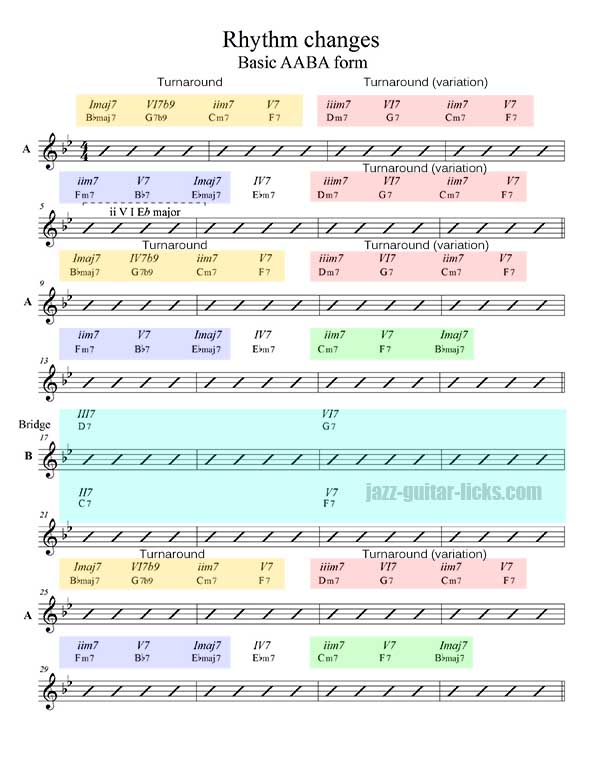
To help you get hear this classic progression here is a list of rhythm changes tunes .
This first example shows you how a Imaj7 - VI7b9 - iim7 - V7 chord progression can be played using drop 3 chords (Bbmaj7 and Cm7) and drop 2 chords (G7b9 and F7).It's in the key of Bb. Please note that the V chord can be altered.
Jazz chord progression # 6 - Turnaround variation - Imaj7 - I#dim7 - iim7 - V7 (Diminished passing chord)
What's a Diminished Passing Chord?
In this variation we will introduce a diminished passing chord between the Imaj7 and the iim7 chord in place of the VI dominant in order to obtain a nice interesting chromatic bass line. That would give in the key of Bb : Bbmaj7 - Bdim7 - Cm7 and F7.

Jazz chord progression # 7 - Turnaround variation - iiim7 - VI7b9 - iim7 - V7.
Another Variation of the Turnaround
There are many versions of the turnaround, one of the most used is when the III chord is played instead of the Imaj7 chord. In the example below, Bbmaj7 is replaced by Dm7 thus giving a new sequence iiim7 - VI7b9 - iim7 - V7. You can find this variation on bars 3-4-7-8-11-12-27-28 of the previous rhythm changes sheet.

To add more interest to this progression and make the pull back to the I chord you can alter the V with a b9 or a b13.
Jazz chord progression # 8 - Turnaround variation - III7 - VI7 - II7 - V7
Turnaround Variation with Dominant 7 chords
In this variation the iiim7 and the iim7 are changed to III7 and II7 thus generating a chain of dominant 7 chords to produce a sense of instability. This type of turnaround is commonly used in jazz blues progressions. The sequence is now III7 - VI7(b9 b13) - II7 - V7alt. Please note that you will maybe need to alter the III chord to fit with the melody.

Please note that you can find this progression in the bridge of rhythm changes on the condition to play two chords per bar.
Jazz chord progression # 9 - Turnaround variation - Tritone substitution
How to Use Tritone Substitutions When Playing a Turnaround ?
Now that the iiim7 has been turned into a III7 we can apply the tritone substitution referred to as the dominant chord substitution. The basic use the tritone sub is to replace the V with a dominant 7th chord whose root is a tritone away.
Example with D7 (V), which can be replaced by Ab7 a tritone apart (three whole-steps). So the previous progression (D7-G7-C7-F7) would become Ab7 - G7 - C7 - F7 (bVII7 - VI7 - II7 - V7).

We can also use a tritone substitute for F7 (V). Thus giving a B7 (#I7), then we get two chromatic movements between Ab7b5 and G7b13 and between C7#9 and B7.

If we keep the III7 chord and use a tritone substitution for G7 (VI7) we get an interesting chromatically descending line : D7-Db7-C7-B7.
Jazz chord progression # 10 | I7 - VI7 - iim7 - V7alt (Jazz, blues turnaround)
How to Incorporate a Turnaround Into a Jazz Blues Progression?
The I7-VI7-iim7-V7 sequence is an essential component of jazz blues. It is placed at the end of a classic 12 bar blues, this is a great way to return to the beginning of a jazz blues progression.
The turnaround is generally accompanied by the same sequence, but rolled out over four bars instead of two measures. We can find this sequence on bars 7-8-9 and 10. Obviously, there are many different jazz blues progressions.
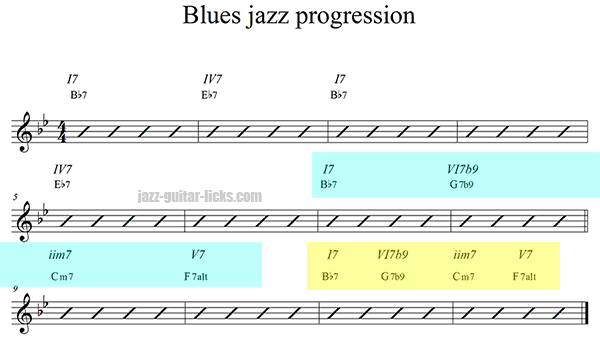
Bb jazz blues progression with drop 2 and drop 3 chords
Here are some chord voicings to illustrate a Bb blues jazz progression. You can see that a diminished passing chord has been added.
It is an E diminished seventh chord (#IVdim7) used frequently in bar 6 of blues jazz tunes. Try to apply the blues, jazz turnaround to the tunes you used to play.
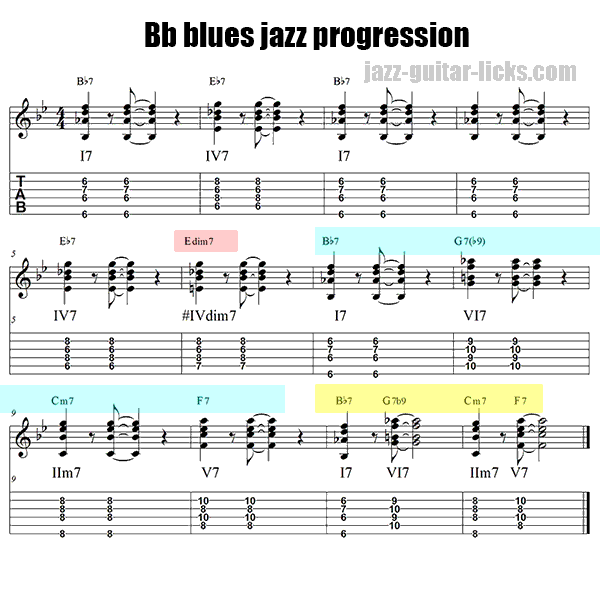
Here Are Some Jazz Blues Tunes to Listen :
- N°1 GREEN STREET by Grant Green (Bb7, G7, Cm7, F7)
- AU PRIVAVE by Charlie Parker (F7, D7, Gm7, C)
- BLUES FOR ALICE by Charlie Parker (F, D7, Gm7, C7)
- BLUES FOR WILLAREN by Grant Green (Bb7, G7, Cm7, F7)
Jazz chord progression # 11 | I7 - IV7 (movement by fourths)
Movement By Fourths
The I7 - IV7 is surely the first progression a guitar student learns to play, so obvious that it is often neglected. However, it is present in many jazz tunes through different types.
Blues
The first example is an essential part of the blues, dominant I chord chord moving to a dominant IV chord.

Rhythm Changes (Bridge)
Another example of movement by fourths is the bridge of rhythm changes, previously seen in this lesson. The bridge involves playing four dominant chords a fourth apart, sometimes referred to as circle of fourths. That's what the bridge of a rhythm change in the key of Bb looks like. Four chords a fourth apart.
| D7 | % | G7 | % |
| III7 | VI7 | ||
| C7 | % | F7 | % |
| II7 | V7 |
Jazz chord progression # 12 | Imaj7 - II7 - IIm7 - V7 - Imaj7 (Take the A train)
What 's the "take the A train" Chord Progression?
The "take the A train" progression takes its name from the most known Duke Ellington tune. This progression includes a II7 chord that goes to iim7 starting point of the major II-V-I sequence. You will see the movement IMaj7 - II7 - iim7 in many jazz tunes as The girl from Ipanema, Desafinado (Carlos Jobim).
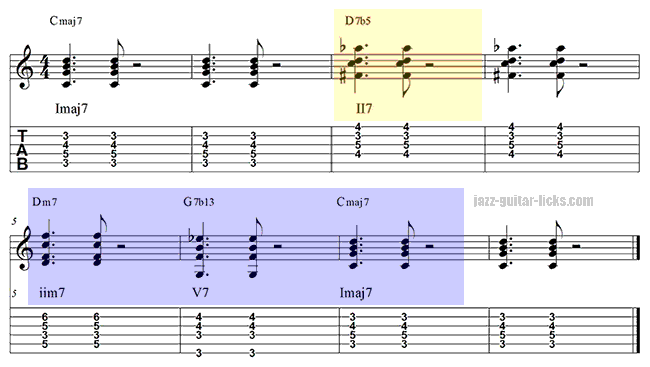
Jazz chord progression #13 | Imaj7 - #Idim7 - IIm7 - #IIdim7 - IIIm7 - VI7 (Passing diminished 7 chords)
How to Connect Chords With Diminished 7 Chords?
Using diminished chords to connect the Imaj7 with the iim7 and with iiim7 is an usual and very important device that will help you add harmonic interest to your playing.
The principle is quite easy to understand, you just have just to introduce diminished chords between the Imaj7, the iim7 and the iiim7 of a major I, ii, iii chord sequence. These diminished chords are located a half-tone above the target chord. This way you will create a chromatic bass line (C, C#, D, D#, E).
Example in the key of C major.
| Cmaj7 | C#dim7 | Dm7 | D#dim7 | Em7 | A7 |
| Imaj7 | #Idim7 | iim7 | #iidim7 | iiim7 | VI7 |
Dim7 Passing Chord on a Rhythm Change
An example of the use of a diminished passing chord can be seen in the first four bars of a rhythm change progression. You can replace the VI7b9 chord with a diminished 7 chord in order to create a chromatic bass line between the Imaj7 and the iim7, thus giving Imaj7 - #Idim7 - iim7 -V7. (check out the chapter 6 of this lesson)
Descending dim7 passing
If you take a look at the tune "How insensitive" you will see a nice example of how to use diminished passing chords in a descending movement, between the iiim7 and iim7 then iim7 and Imaj7.
| D-7 | % | Dbdim7 | % | C-6 | % | Bdim7 | % | Bbmaj7 |
| iiim7 | % | biiidim7 | % | iim7 | % | biim7 | % | Imaj7 |
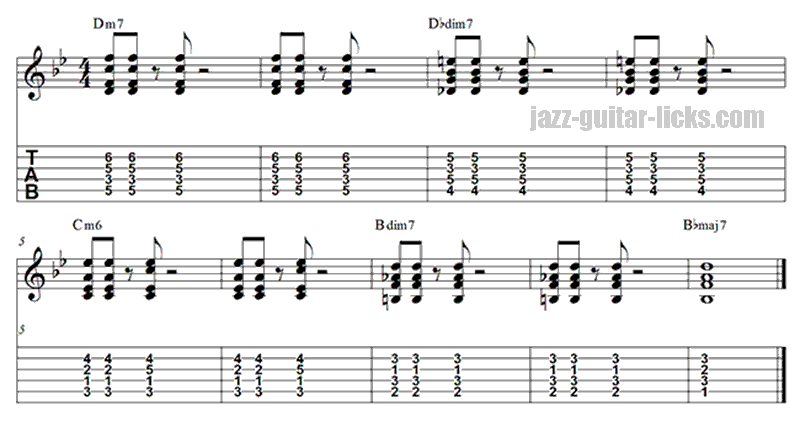
You have understood that diminished passing chords are mostly used to connect other chords and useful devices to work on chord/melody.
Jazz chord progression # 14 | IVmaj7 - ivm7
What's the IV to iv chord sequence ?
The IVmaj7 - ivm7 progression can be found in many jazz tunes as All of me (bars 25-26, F and F-) and All the things you are (bars 25-26, Dbmaj7 and Dbm7) and also in a number of popular songs. Here are the last eight bars of "All of me" to illustrate the IVmaj7 - ivm7 sequence in jazz music.
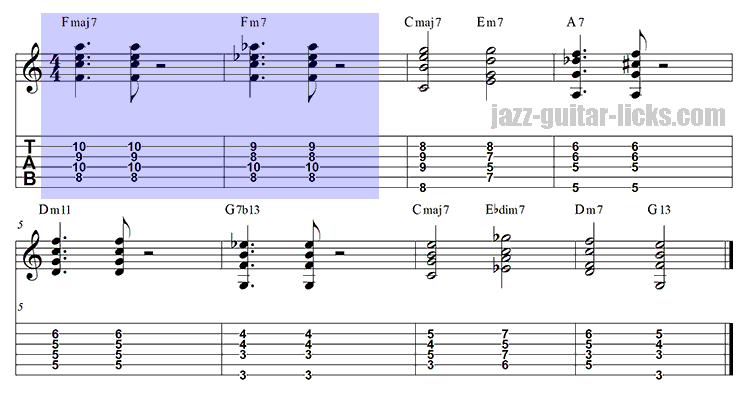
-
Guitar Chord Dictionary
This PDF eBook provides over 550 guitar chord shapes. This is the perfect reference guide to understand how chords are built and how to play them on the guitar neck. -
Guitar Scale Dictionary
This E-book is a printable PDF method including over 700 scale diagrams and formula charts for guitarists. -
Harmonized Scales For Guitar
Complete guitar PDF on harmonized scales: major, minor, harmonic and melodic. Includes chord and arpeggio diagrams, charts and practical tabs. -
172 Arpeggio Shapes For Guitar
This printable PDF is a method dedicated to guitarists of all styles who want to learn build and play the most important types of arpeggios. -
126 Triad Chord Shapes
This handbook for guitar players is intended both for teachers and students. It includes 126 guitar shapes for mastering triads. -
Harmonic Major Scale Chords
this PDF offers diagrams and tabs for guitar to learn the chords of the harmonic major scale. -
Major Scale Harmonization
This package provides a printable PDF with exercises and audio files to learn how to harmonize the major scale with 3 note chords and their extensions. -
30 Minor Arpeggio Licks
This package includes a printable PDF method containing 30 exercises with tabs, staves and audio files for practicing minor arpeggios on guitar. -
II V I Bundle - 170 Exercises
This bundle contains 4 PDF methods for a total of 170 exercises with tabs, staves, analysis & audio files for practicing scales, arpeggios licks & chords over the 2-5-1 progression. -
Diatonic Licks Bundle
This package contains 120 jazz guitar lines based on diatonic modes as Mixolydian, Dorian and Ionian. PDF format with tabs, audio files and analysis. -
30 Groovy Jazz Guitar Licks
This downloadable package contains a PDF WITH audio files giving access to 30 groovy guitar phrases mixing jazz, blues and funky licks for beginners. -
30 Smooth Jazz Guitar Licks
In this package you'll get a printable PDF Method with tabs, notation, analysis, scale shapes and audio files for practicing 30 smooth jazz guitar licks. -
40 II V I Jazz Guitar Licks
This pdf method for guitar contains fourteen 2 5 1 jazz guitar lines with tab, standard notation, analysis, scale charts and audio files. -
50 II-V-I voicings
This printable PDF guitar method provides 50 exercises with audio files, analysis, tab and staves for learning major 2-5-1 chord voicings. -
40 Minor 2 5 1 Chord Voicings
This PDF method contains 40 exercices with tabs, scores and audio files for practicing jazz guitar chords over the minor 2 5 1 progression. -
40 Minor II V I Licks
This guitar method is a printable PDF with tabs, diagrams, theory and audio files providing 40 minor 2 5 1 jazz patterns. -
40 Mixolydian Jazz Guitar Lick
PDF guitar method with tabs, audio files and theory providing 40 dominant jazz guitar lines for teachers and students. -
40 Minor Jazz Guitar Licks
This printable guitar method in PDF format contains 40 easy minor jazz guitar lines based on the Dorian mode. -
40 Major Jazz Guitar Licks
Printable PDF eBook method containing 40 major jazz guitar licks with tab, standard notation and audio files for beginners and intermediates. -
Guitar Walking Bass Lines
This jazz guitar method about walking bass lines and chords is available as a PDF files containing 35 exercises with tabs, analysis and audio files -
101 Dominant Arpeggio Patterns
This printable PDF method provides 101 dominant arpeggio exercises with tab, theory and standard notation for the jazz, blues and rock guitarist. -
49 Essential Jazz Lines
This printable eBook method in PDF format provides 49 jazz solo transcriptions of the greatest jazz musicians. Tab, standard notation, audio files & analysis. -
11 Jazz Blues Studies
11 jazz blues chord studies with tabs, standard notation, analysis, and audio recordings and PDF. -
10 Easy Fingerstyle Blues
This PDF with Tabs and audio files provides 10 easy acoustic fingerstyle blues guitar studies for kids and beginners. -
25 Altered Jazz Guitar Lines
This PDF eBook method contains 25 altered jazz guitar licks with tabs, patterns, scale charts and audio files to master, apply and develop the altered scale. -
40 Blues Dominant Patterns
This printable method is available as a PDF file containing 40 easy dominant jazz-blues guitar lines with tabs, standard notation, analysis, audio files and scale charts. -
25 Pentatonic Licks
This jazz guitar method is an eBook available as a PDF with standard notation, guitar tabs, diagrams, analysis, audio files and backing tracks. You will find in this booklet 25 easy jazz guitar lines with theory using common and rare pentatonic scales. -
25 Soul Jazz Guitar Licks
You will find here an eBook available in PDF containing 25 soul jazz and hard bop guitar licks in the style of Grant Green, Melvin Sparks, George Benson. -
25 Diminished Patterns
This eBook PDF with audio files contains 25 dominant diminished jazz guitar patterns using the half-whole diminished scale and diminished 7th arpeggios. -
6 Tritone substitution licks
This Printable PDF eBook available for free download contains 6 easy jazz guitar licks with tabs/notation, youtube video link and analysis about the tritone substitution. -
10 Minor 7 Arpeggio Patterns
This printable PDF eBook offers 10 easy minor 7 arpeggio patterns with its related YouTube video for beginner guitarists. -
10 Easy Major 7 Arpeggio Licks
This is a printable PDF for beginner jazz guitar players providing 10 easy licks to practice major 7 arpeggios. -
10 Chord Melody Lines
Within this package, you'll discover a set of ten chord melody exercises for beginners. Printable PDFaudio files, a backing track, and a link to the associated YouTube video. -
10 Minor Blues Scale Licks
You'll find here a PDF with 10 easy jazz guitar licks to practice the minor blues scale on guitar.
-
Guitar Arpeggios Poster
This giant guitar poster for any guitar player, student or instructor contains colorful arpeggio diagrams. Giant size 24 x 36 inches (60 x 90 cm). -
Guitar Scales Poster 24*36
Guitar posters and wall art with eighteen neck diagrams representing the most used scales in music. -
Guitar Chord Poster
This printed color posters contains 63 guitar chord diagrams for jazz players, students, teachers and schools. -
Guitar Modes Poster
Guitar reference posters and wall art about modes of the major scale for guitar teachers, students and music schools. -
Melodic Minor Modes Poster
Educative and decorative giant guitar poster with neck diagrams, interval names about the seven modes of the melodic minor scale. -
Pentatonic Scale Guitar Poster
This guitar reference poster shows the positions and intervals of the major pentatonic scale. -
Guitar Notes Poster
This is a giant poster showing the notes on the guitar fret board and their positions on a musical staff. -
Triads Guitar Poster
This reference poster show the positions and intervals of the main triads used on guitar. This is a useful tool for guitarists, teacher and students. -
Four Archtop Guitars Poster
This is a decorative poster with four archtop jazz guitars. Several size and colors in landscape format available on Teespring and redbubble. -
Intervals On Guitar - Poster
This giant poster for guitar provides neck diagrams with interval positions. -
Melodic Minor Modes
This music theory poster available in several sizes shows the construction of the seven modes of the melodic minor scale. -
Major Scale Chords
This handy poster provides a clear visual guide to the chords built from the major scale, helping you recognize patterns and improve your playing. -
Melodic Minor Chords
Explore the rich harmonic possibilities of the melodic minor scale with this essential guitar poster. -
Harmonic Minor Modes
This music theory poster, offered in various sizes, demonstrates the structure of the seven modes of the melodic minor scale. -
Harmonic Minor Chords
Discover the chords of the harmonic minor scale with this guitar poster. -
Major Scale Modes
This poster is created for music teachers and students, illustrating the structure of the seven modes of the major scale.
II-V-I jazz guitar chords chords Rhythm changes turnarounds
Comments
-

- 1. Samuel Wkande On 2025-09-24
I need more information on jazz guitar chords and soloing-
- jazz-guitar-licksOn 2025-11-21
What do you want to know?
-

- 2. Jared On 2020-11-29
In your first example, is it correct for Cmaj7 to use 3543 other than 3545?-
- jazz-guitar-licksOn 2020-11-29
This can be seen as Cmaj9.
-

- 3. Mixjal On 2020-11-26
thx much for the invitation :).
PS: How are you? I am from France :) very good forum :) mixx -

- 4. Elias On 2020-08-30
In the 3rd progression in the 2nd example is a mistake. You have to change the 10 10 10 10 which should describe a Cm7 in the TABs to 8 8 8 8-
- jazz-guitar-licksOn 2020-08-31
Thanks this is corrected ;)
-

- 5. Christopher Nowak BFA MLIS On 2020-01-14
I am not sure if some readers have heard of DON CARLO GESUALDO ( a very chromatic composer from the Renaissance period).
Try improvising on this chord progression: Emajor7-Cminor7-Gmajor7-Efalt minor7 etc…
I composed my own jazz song using this idea (JUNE IN STRANGEVILLIE). -

- 6. Stefan Joubert On 2017-11-02
Beautiful analysis Stef Ramin!
I always make all my students learn the I IV VIII III VI II V I chord progression (through all keys), and I also try to get them to memorise it where possible. (Again all 12 keys)
The amazing things is that most jazz is just a cycle of fourths with tritones resolving...
It soooo simply, yet so complex at the same time and that is the beauty of jazz!
Thanks again for this beautiful article - much appreciated!-
- jazz-guitar-licksOn 2017-11-02
Hi Stefan, very interesting, thanks for your contribution. Stef
Add a comment








